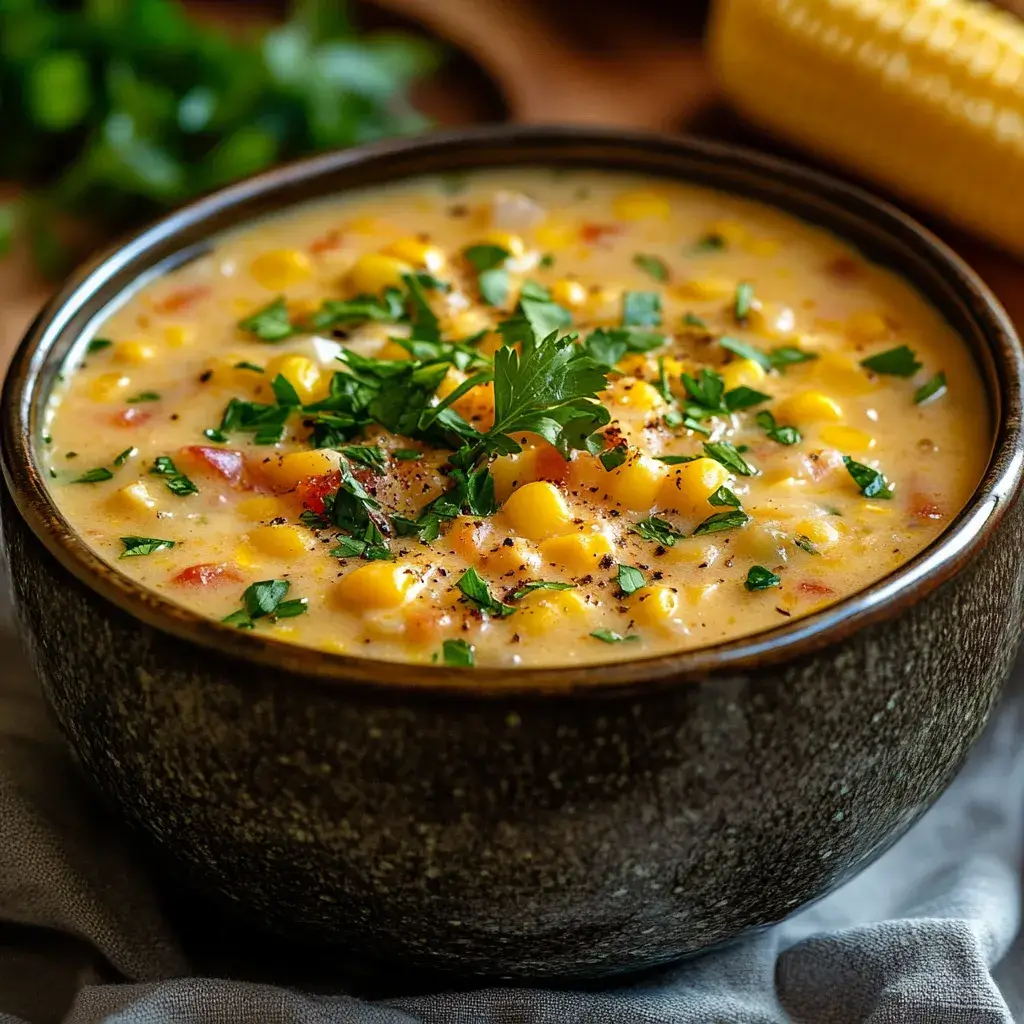Corn Chowder Recipe is one of those dishes that brings warmth and comfort to any table. Whether you’re looking for a hearty meal during the colder months or simply craving something creamy and satisfying, this soup never disappoints. In this comprehensive guide, we’ll walk you through everything you need to know about making corn chowder, from understanding its origins to mastering various techniques and variations. By the end of this post, you’ll be equipped with all the knowledge needed to create your own delicious bowl of homemade corn chowder.
What Is Corn Chowder Recipe?
Definition and Origin
Corn Chowder Recipe is a rich, creamy soup made primarily with fresh corn kernels, potatoes, onions, and dairy products like cream or milk. Its roots can be traced back to traditional New England-style chowders, which were originally seafood-based soups influenced by European settlers. Over time, corn became a popular addition due to its abundance in North America, giving rise to what we now know as Corn Chowder Recipe.
This dish gained popularity because it combines simple yet flavorful ingredients into a comforting meal. While some versions incorporate additional vegetables or proteins, the core elements remain consistent—corn, potatoes, and a creamy base. Today, Corn Chowder Recipe is enjoyed across the globe, with each region adding its unique twist to the classic recipe.
Key Ingredients in Corn Chowder Recipe
To make an authentic Corn Chowder Recipe, you’ll need the following key ingredients:
- Fresh Corn Kernels : Fresh corn provides the sweet, natural flavor that defines this dish. If fresh corn isn’t available, frozen corn works just as well but may lack the same level of sweetness.
- Potatoes : These starchy tubers add thickness and texture to the chowder. Choose waxy varieties like Yukon Gold for better holding power when cooked.
- Onions and Celery : These aromatic vegetables form the foundation of the soup’s flavor profile. Sautéing them creates depth and enhances the overall taste.
- Cream or Milk : A creamy base is essential for achieving the signature richness of Corn Chowder Recipe. Heavy cream offers the richest flavor, but whole milk or half-and-half are great alternatives for lighter options.
- Butter : Butter adds richness and helps develop flavors during the initial cooking stages. For a healthier option, olive oil or coconut oil can be used.
- Seasonings : Salt, pepper, thyme, paprika, and cayenne pepper are common seasonings that elevate the dish without overpowering the natural sweetness of the corn.
Types of Corn Chowder Recipe
While the basic recipe remains consistent, there are several variations of Corn Chowder Recipeto suit different tastes and dietary preferences:
- Creamy Corn Chowder Recipe : This version emphasizes the use of heavy cream or milk for maximum richness. It’s perfect for those who love decadent, velvety textures.
- Vegetarian Corn Chowder Recipe : Ideal for plant-based eaters, this variation omits animal-derived ingredients entirely. Instead, vegetable broth and non-dairy milks like almond or oat milk are used.
- Seafood-Infused Corn Chowder Recipe : Adding shellfish such as shrimp or clams transforms the humble Corn Chowder Recipe into a luxurious seafood experience. Be sure to balance the flavors so the corn doesn’t get lost amidst the seafood.
- Spicy Corn Chowder Recipe : Incorporating chili peppers, jalapeños, or hot sauce gives this version a fiery kick. Perfect for spice lovers!
Why Corn Chowder Is a Must-Try
There’s no denying the appeal of corn chowder. Not only does it satisfy hunger, but it also warms the soul with its comforting qualities. Here’s why you should give it a try:
- Versatility : Corn chowder adapts easily to various diets and preferences, whether you’re vegetarian, gluten-free, or simply seeking a new twist on tradition.
- Ease of Preparation : With minimal effort, you can whip up a batch of corn chowder using readily available ingredients. Plus, most recipes require less than an hour of active cooking time.
- Comfort Food Appeal : There’s something inherently soothing about enjoying a steaming bowl of corn chowder on a chilly evening. Pair it with crusty bread or a side salad for a complete meal.
How to Make Corn Chowder
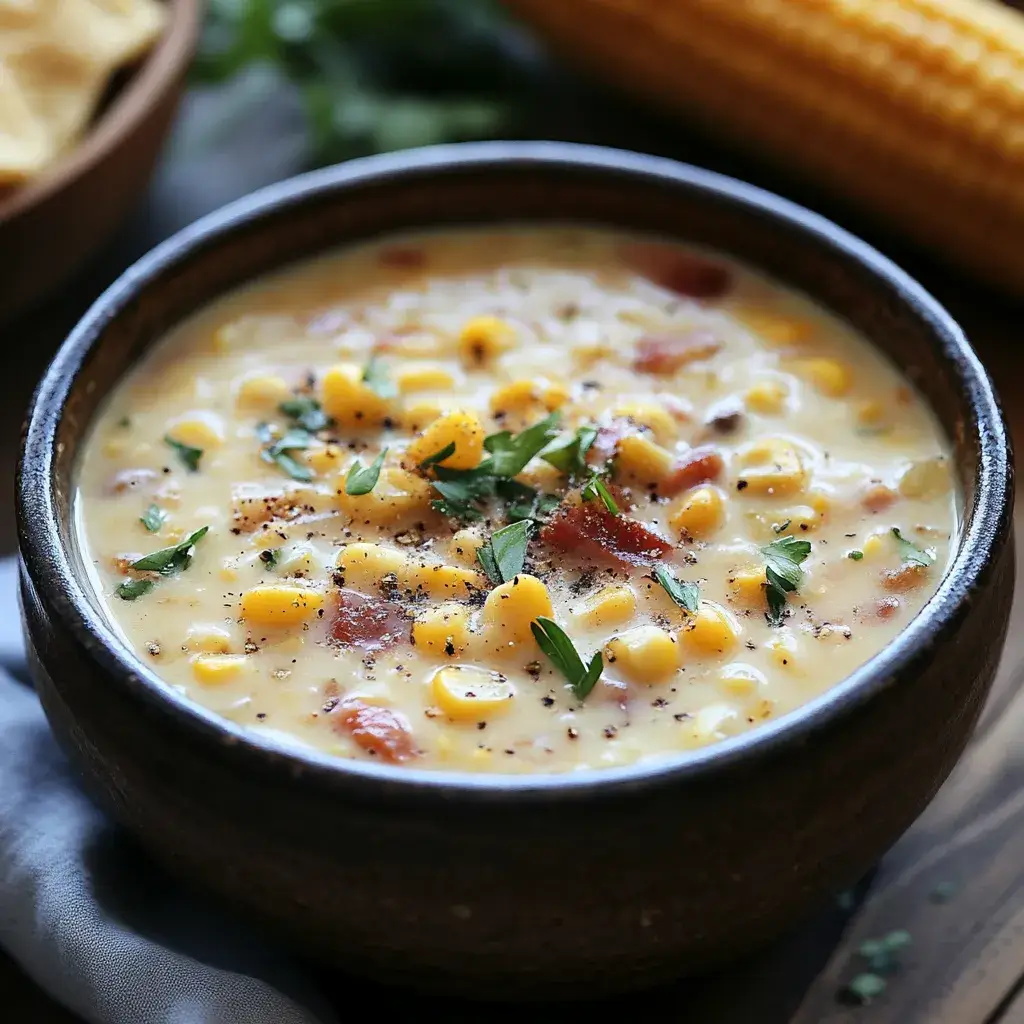
Step 1 – Gather Your Ingredients
Before diving into the cooking process, ensure you have all the necessary ingredients on hand. Here’s a detailed list:
- Fresh or frozen corn kernels (about 4 cups)
- Potatoes, diced (2 medium-sized)
- Onion, finely chopped (1 large)
- Celery stalks, sliced (2–3)
- Garlic cloves, minced (2–3)
- Butter or oil (2–3 tablespoons)
- Vegetable broth or water (4 cups)
- Cream or milk (1–2 cups)
- Flour or cornstarch (optional, for thickening)
- Seasonings: salt, pepper, thyme, paprika, cayenne pepper
If you’re substituting any ingredients, consider the following:
- Use coconut milk instead of cream for a tropical flair.
- Replace butter with olive oil for a lighter option.
Step 2 – Prepare the Base
Start by heating your butter or oil in a large pot over medium heat. Once melted, add the chopped onion and celery, sautéing until they become translucent and fragrant. This step develops the foundational flavors of your chowder.
Next, toss in minced garlic and cook for another minute, being careful not to burn it. At this point, introduce the diced potatoes and let them cook briefly to absorb the aromas. Stirring frequently ensures even cooking and prevents sticking.
Finally, pour in the vegetable broth or water, ensuring the potatoes are fully submerged. Bring the mixture to a boil, then reduce the heat to low and simmer until the potatoes soften—usually around 15–20 minutes.
Step 3 – Simmer and Thicken
Once the potatoes are tender, it’s time to incorporate the corn kernels. Add them to the pot and continue simmering for another 5–10 minutes. During this stage, you can adjust the consistency of your chowder if desired.
For a thicker texture, remove about one cup of the liquid and potato mixture. Blend it in a blender or food processor until smooth, then return it to the pot. Alternatively, whisk in a slurry made from flour or cornstarch mixed with cold water.
Step 4 – Finish with Cream and Seasoning
With the base prepared, it’s time to finish the chowder by adding cream or milk. Gradually stir in your chosen dairy product, allowing it to heat through without boiling. Boiling can cause the cream to curdle, ruining the silky texture.
Now comes the fun part—seasoning! Start with a pinch of salt and pepper, followed by herbs like thyme and paprika. For a hint of heat, sprinkle in some cayenne pepper. Taste the chowder as you go, adjusting the seasonings until it reaches your desired flavor profile.
Tips for Perfect Corn Chowder
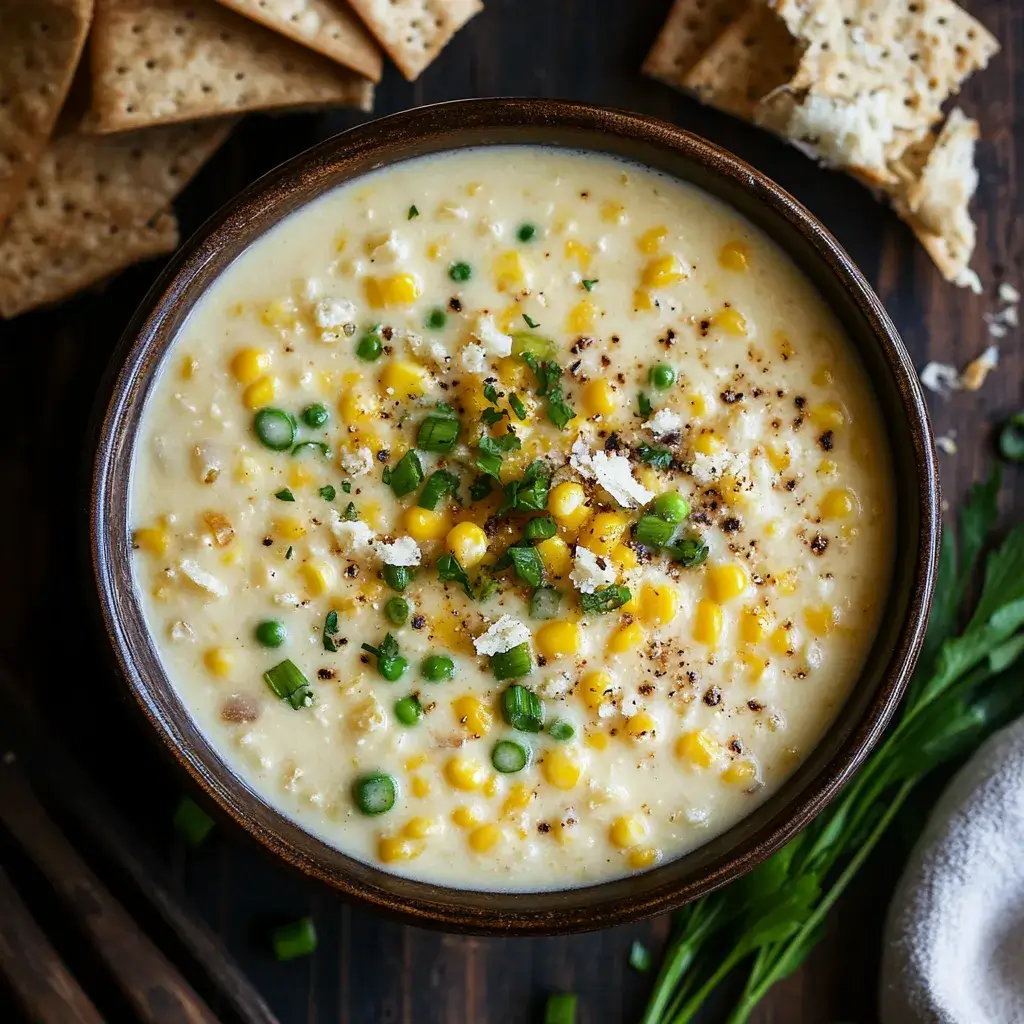
Choose Fresh Corn
When possible, opt for fresh corn on the cob. To prepare, shuck the husks and scrape the kernels off the cob using a sharp knife. Fresh corn imparts a sweeter, more vibrant flavor compared to canned or frozen alternatives. However, if fresh corn isn’t available, high-quality frozen corn works just fine.
Adjust Consistency
One of the hallmarks of good corn chowder is its creamy, velvety texture. Achieving the right consistency involves balancing liquids and solids. If your chowder turns out too thin, try blending part of it or adding a flour slurry. Conversely, if it’s overly thick, stir in extra broth or milk until it reaches your preferred viscosity.
Enhance Flavor with Herbs
Herbs play a crucial role in elevating the flavor of corn chowder. Consider these options:
- Parsley : Adds freshness and brightness.
- Basil : Complements the sweetness of corn with its aromatic notes.
- Cilantro : Provides a zesty contrast that pairs beautifully with spicy versions.
Add herbs toward the end of cooking to preserve their delicate flavors.
Serve It Hot
Serving corn chowder at the right temperature makes all the difference. Ladle it into bowls immediately after preparation and garnish with a sprinkle of fresh herbs or shredded cheese for added flair. For best results, serve alongside complementary sides like garlic bread, cornbread, or a crisp green salad.
Variations of Corn Chowder
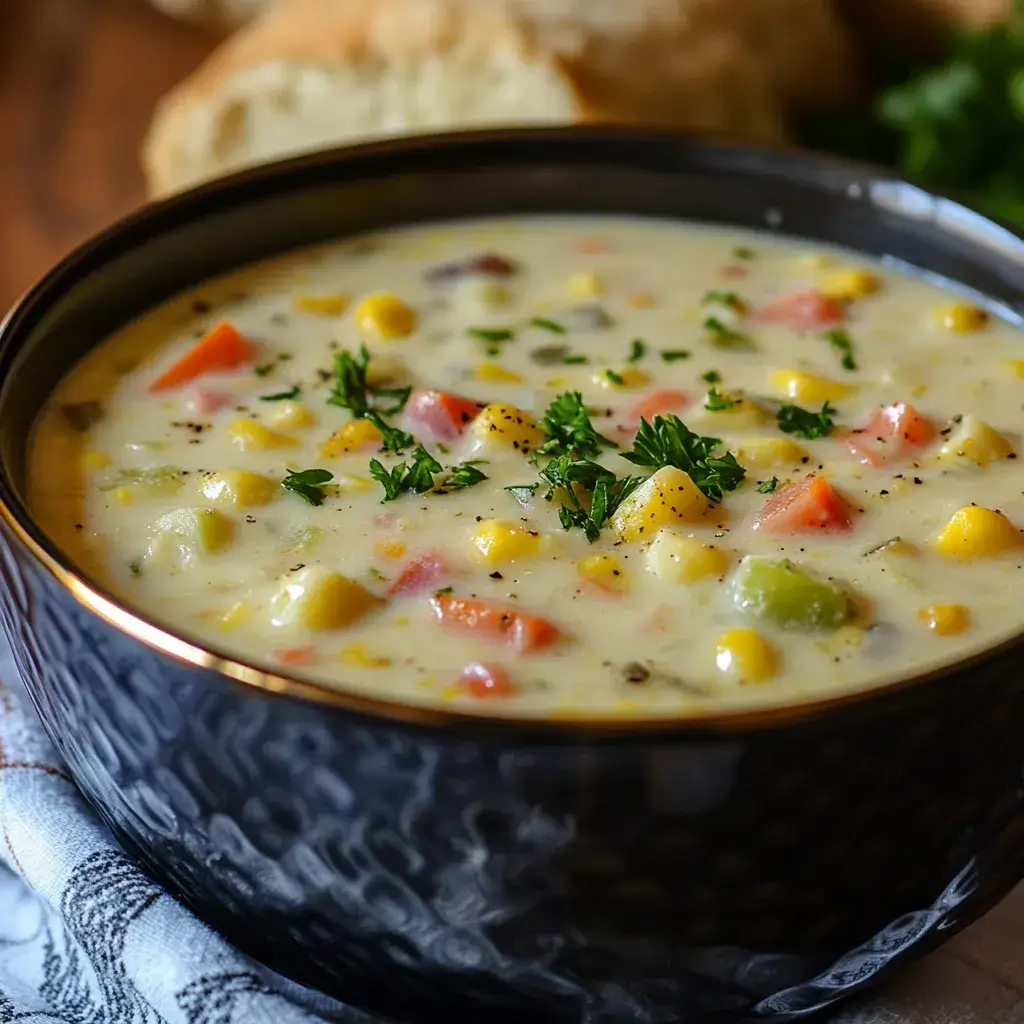
Vegetarian Corn Chowder
Creating a vegetarian version of corn chowder ensures that everyone can enjoy this comforting dish, regardless of dietary preferences. Here’s how you can make it both flavorful and inclusive:
1. Start with Plant-Based Alternatives
- Butter Substitute : Replace butter with olive oil, coconut oil, or vegan margarine. These options not only mimic the richness of butter but also add unique flavors depending on your choice.
- Olive Oil : Adds a mild fruity note.
- Coconut Oil : Provides a subtle tropical undertone (use refined coconut oil if you prefer no coconut flavor).
- Vegan Margarine : Offers a neutral taste closest to traditional butter.
- Broth Selection : Use vegetable broth instead of chicken or beef broth. Look for low-sodium varieties to control salt levels and enhance other ingredients’ natural flavors.
2. Enhance Flavor with Aromatics
Vegetarians often rely on herbs and spices to elevate their dishes. Incorporate these aromatic elements into your corn chowder:
- Garlic and Onions : Sauté them until golden brown for maximum flavor development.
- Celery and Carrots : Known as part of the “mirepoix,” these vegetables form the backbone of many soups and stews.
- Bay Leaves and Thyme : Add dried or fresh herbs during cooking to infuse deeper layers of taste.
3. Protein-Rich Additions
While corn chowder isn’t traditionally protein-heavy, vegetarians can incorporate plant-based proteins to make it more filling:
- Lentils or Chickpeas : Cooked lentils or chickpeas add texture and nutrition without altering the soup’s overall profile.
- Tofu or Tempeh : Crumble firm tofu or tempeh and sauté briefly before adding to the chowder for a savory boost.
- Nutritional Yeast : Sprinkle nutritional yeast over the finished dish for a cheesy, umami-rich finish.
4. Creamy Texture Without Dairy
Achieving a creamy consistency in vegetarian corn chowder requires creative substitutions:
- Non-Dairy Milks : Almond milk, oat milk, soy milk, or coconut milk work wonderfully. Choose unsweetened versions to avoid unwanted sweetness.
- Cashew Cream : Blend soaked cashews with water for a homemade cream substitute that rivals dairy in richness.
- Potato Puree : Blending some cooked potatoes back into the soup thickens it naturally while maintaining a smooth texture.
5. Final Touches
Finish your vegetarian corn chowder with garnishes that highlight its flavors:
- Fresh parsley or cilantro
- A drizzle of olive oil
- Crushed red pepper flakes for heat
By following these steps, you’ll create a vibrant, satisfying vegetarian corn chowder that rivals its non-vegetarian counterparts.
Gluten-Free Corn Chowder
Making gluten-free corn chowder is straightforward, as most ingredients are naturally free from gluten. However, there are a few key adjustments to ensure complete compliance with gluten-free diets.
1. Avoid Hidden Gluten Sources
Even though corn chowder doesn’t typically contain gluten, cross-contamination can occur. Be mindful of:
- Flour : If using flour to thicken the chowder, opt for gluten-free all-purpose flour or rice flour.
- Pre-made Broths : Some store-bought broths may contain gluten. Always check labels or use homemade broth to be safe.
2. Thickening Agents
Replace traditional wheat-based thickeners with gluten-free alternatives:
- Cornstarch : Mix cornstarch with cold water to create a slurry, then stir it into the simmering chowder for a quick thickening effect.
- Arrowroot Powder : Similar to cornstarch, arrowroot powder creates a glossy, smooth texture without affecting flavor.
- Xanthan Gum : A small amount of xanthan gum can help bind ingredients together, especially if you’re blending part of the soup.
3. Dairy Considerations
Most dairy products are gluten-free, but double-check labels for processed items like cream or cheese. If avoiding dairy altogether, use gluten-free plant-based milks such as almond, oat, or coconut milk.
4. Seasonings and Spices
Ensure all seasonings and spice blends are certified gluten-free. Many commercial mixes include gluten-containing fillers, so it’s safer to make your own blend:
- Salt and pepper
- Ground thyme, paprika, and cayenne pepper
- Fresh herbs like basil, parsley, or dill
5. Serving Suggestions
When serving gluten-free Corn Chowder Recipe, pair it with sides that complement its flavors while staying within dietary guidelines:
- Gluten-free bread or crackers
- Quinoa salad
- Roasted vegetables like carrots, zucchini, or bell peppers
With these simple modifications, your gluten-free Corn Chowder Recipe will be just as delicious and comforting as the original recipe.
Seafood Corn Chowder Recipe
Adding seafood transforms Corn Chowder Recipe into a luxurious dish perfect for special occasions or seafood lovers. Here’s how to balance the delicate flavors of shellfish with the sweetness of corn.
1. Choosing Your Seafood
Select high-quality, fresh seafood for the best results. Popular options include:
- Shrimp : Easy to prepare and widely available, shrimp adds a sweet, briny flavor.
- Scallops : Delicate and tender, scallops bring elegance to the dish.
- Clams : Their salty, oceanic taste complements the corn beautifully. Use canned clams for convenience or fresh ones for superior flavor.
2. Preparing the Seafood
To prevent overcooking, prepare the seafood separately from the chowder:
- Shrimp : Peel and devein raw shrimp, then sauté them in olive oil or butter until pink and opaque.
- Scallops : Pat dry and sear quickly in hot oil for a caramelized exterior.
- Clams : Steam them in white wine or vegetable broth until they open, discarding any unopened shells.
3. Integrating Seafood into the Chowder
Once the seafood is cooked, gently fold it into the finished chowder just before serving. This preserves its texture and prevents overcooking. Alternatively, serve the seafood on top of the chowder as a garnish.
4. Balancing Flavors
Seafood Corn Chowder Recipe requires careful seasoning to ensure the corn doesn’t get overshadowed:
- Use light-handed amounts of salt, as seafood already contains natural salinity.
- Enhance the dish with lemon juice or zest for brightness.
- Add herbs like dill, tarragon, or parsley to complement the seafood.
5. Garnishing Ideas
Finish your seafood Corn Chowder Recipe with elegant touches:
- Chopped fresh herbs
- A dollop of sour cream or crème fraîche
- Toasted breadcrumbs for crunch
This variation elevates the humble Corn Chowder Recipe into a gourmet experience worthy of any dinner table.
Low-Carb Corn Chowder Recipe
For those following low-carb diets, making Corn Chowder Recipe involves swapping out starchy ingredients for lower-carbohydrate alternatives. Here’s how to do it effectively:
1. Replacing Potatoes
Potatoes are a primary carb source in traditional Corn Chowder Recipe. Replace them with these low-carb substitutes:
- Cauliflower : Rice or mash cauliflower to mimic the texture of potatoes. It absorbs flavors well and reduces carb content significantly.
- Zucchini : Diced zucchini adds moisture and nutrients without contributing excessive carbs.
- Mashed Turnips : Another great alternative, turnips provide a similar earthy flavor and density.
2. Adjusting Dairy
Dairy products contribute fats and minimal carbs, so they remain suitable for low-carb diets. Opt for:
- Whole milk or heavy cream for creaminess.
- Unsweetened almond or coconut milk for lighter options.
3. Reducing Sugar Content
Corn itself contains natural sugars, but you can minimize additional carbs by:
- Using fewer corn kernels or opting for frozen corn, which has slightly lower sugar content than fresh.
- Adding extra vegetables like spinach or kale to dilute the corn’s sweetness.
4. Thickening Techniques
Avoid flour or cornstarch, which are high in carbs. Instead, use:
- Blended Vegetables : Puree part of the soup to thicken naturally.
- Xanthan Gum or Guar Gum : Tiny amounts of these gums can achieve the desired thickness without adding carbs.
5. Seasoning Creatively
Low-carb seasonings enhance flavor without compromising the diet:
- Smoked paprika for depth.
- Hot sauce or chili flakes for heat.
- Lemon juice or vinegar for tanginess.
6. Serving Suggestions
Pair your low-carb Corn Chowder Recipe with keto-friendly sides:
- Grilled or roasted vegetables.
- Avocado slices for healthy fats.
- Cauliflower crust pizza or lettuce wraps.
By focusing on smart ingredient swaps and thoughtful preparation, you can craft a satisfying low-carb Corn Chowder Recipe that fits seamlessly into any diet plan.
If you’re looking for additional inspiration, check out this classic Grandma’s Corn Chowder recipe from AllRecipes , which has been a favorite among home cooks for years. It’s a great starting point for mastering the art of corn chowder!
FAQs About Corn Chowder Recipe
Can I Freeze Corn Chowder?
Yes, corn chowder freezes beautifully, though there are a few considerations to keep in mind. Cream-based soups tend to separate upon thawing, so stir well before reheating. For best results, freeze individual portions in airtight containers for up to three months.
How Long Does Corn Chowder Last?
Stored properly in the refrigerator, corn chowder stays fresh for 3–4 days. Always reheat it thoroughly before consuming and discard any leftovers showing signs of spoilage.
Is Corn Chowder Healthy?
Corn chowder can be nutritious depending on the ingredients used. Corn provides fiber and vitamins, while potatoes contribute potassium and energy. However, the calorie count increases with the addition of cream and butter. To make it healthier, opt for skim milk, reduce fat content, and increase vegetable portions.
What Goes Well with Corn Chowder?
Pair corn chowder with foods that complement its creamy, savory nature:
Garlic Bread : Crusty, garlicky goodness pairs perfectly with the soup.
Cornbread : A Southern classic that mirrors the sweetness of the chowder.
Caesar Salad : Light and refreshing, this salad balances the richness of the soup.
Conclusion
Corn chowder is more than just a soup—it’s a celebration of seasonal ingredients and comforting flavors. From understanding its origins to mastering various techniques and variations, this guide equips you with everything needed to create a memorable dish. So gather your ingredients, roll up your sleeves, and enjoy the satisfaction of crafting a bowl of homemade corn chowder. Happy cooking!
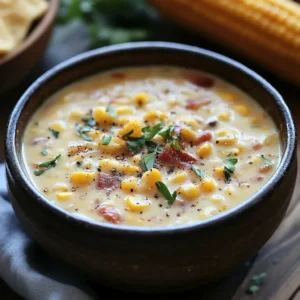
Corn Chowder
Equipment
- Large pot or Dutch oven
- Wooden spoon or spatula
- Knife and cutting board (for chopping ingredients)
- Measuring cups and spoons
- Immersion blender (optional, for creaminess)
Ingredients
- For the Chowder:
- 6 slices bacon chopped
- 1 medium onion diced
- 2 celery stalks diced
- 2 garlic cloves minced
- 3 medium potatoes peeled and diced into small cubes
- 4 cups chicken broth low-sodium preferred
- 3 cups fresh or frozen corn kernels divided
- 1 cup heavy cream or half-and-half for a lighter option
- 2 tablespoons all-purpose flour
- 2 tablespoons unsalted butter
- Salt and pepper to taste
- Optional: Fresh parsley chopped, for garnish
Instructions
- Cook the Bacon :
- In a large pot or Dutch oven over medium heat, cook the chopped bacon until crispy. Remove the bacon with a slotted spoon and set aside, leaving the bacon grease in the pot.
- Sauté the Vegetables :
- Add the diced onion and celery to the pot with the bacon grease. Sauté for 5–7 minutes, stirring occasionally, until softened.
- Stir in the minced garlic and cook for 1 minute until fragrant.
- Add the Potatoes and Broth :
- Add the diced potatoes and chicken broth to the pot. Bring the mixture to a boil, then reduce the heat to low. Simmer for 10–12 minutes, or until the potatoes are tender.
- Blend for Creaminess (Optional) :
- Use an immersion blender to partially blend the soup, leaving some chunks of potato and corn for texture. Alternatively, blend 1–2 cups of the soup in a regular blender and return it to the pot.
- Thicken the Chowder :
- In a small bowl, whisk together the flour and 2 tablespoons of the soup liquid to create a slurry. Stir the slurry back into the pot to thicken the chowder.
- Finish with Corn and Cream :
- Add 2 cups of the corn kernels and the heavy cream to the pot. Simmer for 5–7 minutes, ensuring the soup is heated through but not boiling after adding the cream.
- Season and Serve :
- Stir in the remaining 1 cup of corn kernels and season with salt and pepper to taste. Let the chowder simmer for 2–3 more minutes.
- Ladle the chowder into bowls. Top with the crispy bacon and garnish with freshly chopped parsley if desired.
Notes
Use vegetable broth and omit bacon for a vegetarian version.
Store leftovers in an airtight container in the refrigerator for up to 4 days. Reheat gently on the stovetop, adding a splash of broth if needed to loosen the soup.
Freeze portions of the chowder (without cream) for up to 3 months. Thaw overnight in the refrigerator, then reheat and add cream before serving.

